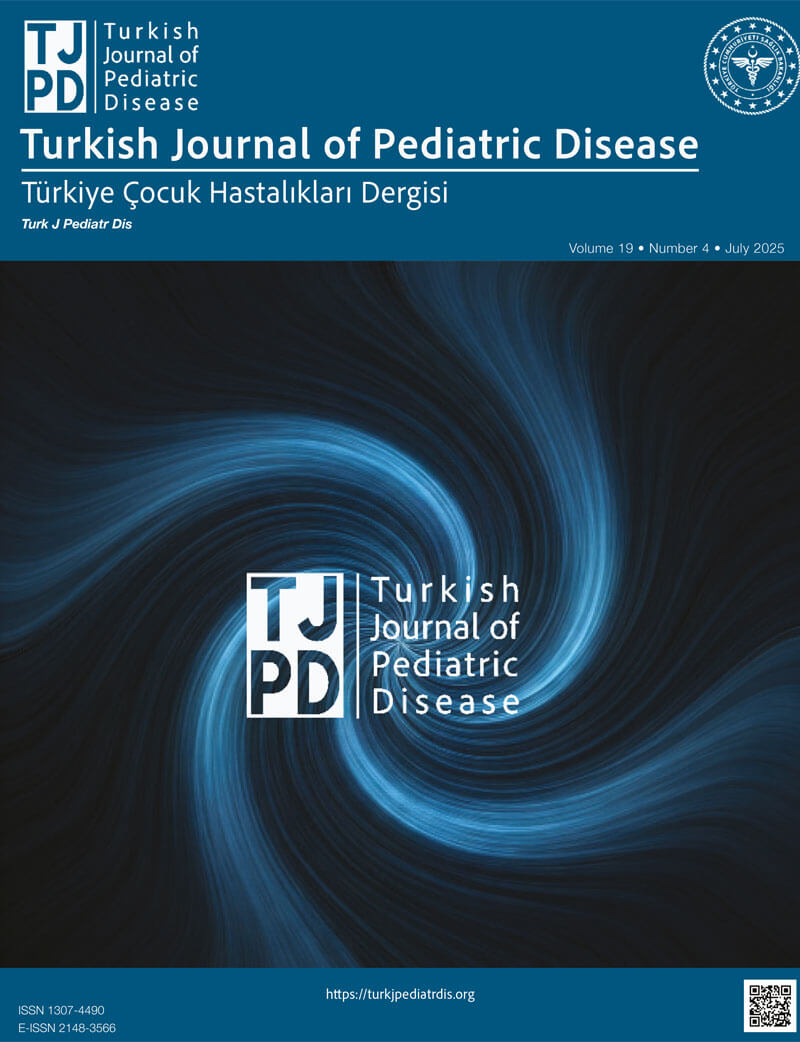Abstract
Objective: With advancements in endourological equipment and the routine use of the Holmium:YAG laser, endoscopic treatment has become the first-line approach for managing ureteral stones in children. Although ureteroscopy is widely performed, the literature reports varying outcomes regarding its efficacy in pediatric cases. This study aimed to evaluate the impact of increasing endourological experience on stone-free rates and procedure-related complications in children undergoing ureteroscopy with Holmium: YAG laser for ureteral stones
Material and Methods: A comparative analysis was conducted on 32 cases treated with URS for ureteral stones between 2009-2011, the initial three years of our endourological interventions in children, and 78 cases treated with URS for ureteral stones between 2020-2022, the final three years of our 15-year endourological experience, utilising hospital records as the primary data source. Demographic data, stone-free rates, and recorded complications were evaluated in both groups.
Results: In our initial cohort of 32 cases, the stone-free rate at first attempt was 57%, with a complication rate of 15.6% and a conversion rate to open surgery of 18.75%. In contrast, during the last three years, 73 patients (93.5%) achieved stone-free status with a single URS session. Only one case (1.3%) required conversion to open surgery. Complications were observed in 10.2% of cases. Notably, the use of passive dilation with preoperative JJ stent placement became more prevalent during the latter period.
Conclusion: Increasing surgical experience is associated with higher stone-free rates following a single intervention. There were no significant differences in the overall or major complication rates between the two periods. Postoperative fever remains a common complication, underscoring the importance of careful management of JJ stent placement. The most notable parameter that showed a significant improvement with increased experience was the reduced rate of conversion to open surgery.
Keywords: Children, Complication, Ureteroscopy, Ureterolithiasis
References
- Clayton DB, Pope JC. The increasing pediatric stone disease problem. Ther Adv Urol 2011;3:3-12. https://doi.org/10.1177/1756287211400491.
- Glazer K, Brea IJ, Leslie SW, Vaitla P. Ureterolithiasis. 2024 Apr 20. In: StatPearls (Internet). Treasure Island (FL): StatPearls Publishing; 2025 Jan-. PMID: 32809509.
- Carmen Tong CM, Ellison JS, Tasian GE. Pediatric Stone Disease: Current Trends and Future Directions. Urol Clin North Am 2023; 50:465-75. https://doi.org/10.1016/j.ucl.2023.04.009.
- Tiryaki T, Azili MN, Özmert S. Ureteroscopy for treatment of ureteral stones in children: factors influencing the outcome. Urology 2013;81:1047-51. https://doi.org/10.1016/j.urology.2013.01.008.
- Smaldone MC, Cannon GM Jr, Wu HY, Bassett J, Polsky EG, Bellinger MF, et al. Is ureteroscopy first-line treatment for pediatric stone disease? J Urol 2007;178:2128- 31. https://doi.org/10.1016/j.juro.2007.07.050.
- Mosquera L, Pietropaolo A, Madarriaga YQ, Knecht EL, Jones P, Tur AB, et al. Is Flexible Ureteroscopy and Laser Lithotripsy the New Gold Standard for Pediatric Lower Pole Stones? Outcomes from Two Large European Tertiary Pediatric Endourology Centers. J Endourol 202;35:1479-82. https://doi.org/10.1089/end.2020.1123.
- Zhao Y, Wang X, Zhao F, Yang B, Tian Y, Li J. Outcomes of retrograde ureteroscopy in Chinese infants and toddlers under 3 years old with ureteric stones from a single center. J Pediatr Urol. 2024;20:395-9. https://doi.org/10.1016/j.jpurol.2023.12.003.
- Faure A, Paye Jaouen A, Demede D, Juricic M, Arnaud A, Garcia C, et al. Safety and feasability of ureteroscopy for pediatric stone, in children under 5 Years (SFUPA 5): A French multicentric study. J Pediatr Urol. 2024;20: 225.e1-225.e8. https://doi.org/10.1016/j.jpurol.2023.11.016.
- Thomas JC, DeMarco RT, Donohoe JM, Adams MC, Brock JW 3rd, et al. Pediatric ureteroscopic stone management. J Urol. 2005;174:1072-4. https://doi.org/10.1097/01.ju.0000169159.42821.bc.
- El-Nahas AR, El-Tabey NA, Eraky I, Shoma AM, El-Hefnawy AS, El-Assmy AM, et al. Semirigid ureteroscopy for ureteral stones: a multivariate analysis of unfavorable results. J Urol. 2009;181:1158-62. https://doi.org/10.1016/j.juro.2008.10.167.
- C Esposito, L Masieri, V Bagnara, Tokar B, Golebiewski A, Escolino M. Ureteroscopic lithotripsy for ureteral stones in children using holmium: yag laser energy: results of a multicentric survey. J Pediatr Urol. 2019;5:391.e1-391.e7. https://doi.org/10.1016/j.jpurol.2019.05.004.
- Jones P, Rob S, Griffin S,Somani BK. Outcomes of ureteroscopy (URS) for stone disease in the paediatric population: results of over 100 URS procedures from a UK tertiary center. World J Urol. 2020;38:213-8. https://doi.org/10.1007/s00345-019-02745-3.
- Ripa F, Tokas T, Griffin S, Ferretti S, Tur AB, Somani BK. Role of Pediatric Ureteral Access Sheath and Outcomes Related to Flexible Ureteroscopy and Laser Stone Fragmentation: A Systematic Review of Literature. Eur Urol Open Sci. 2022;45:90-8. https://doi.org/10.1016/j.euros.2022.09.012.
- Fahmy A, Dawoud W, Badawy H, Youssif M, Kamal A, Elgebaly O. Optimum duration of ureteral prestenting dwelling time in children undergoing retrograde intrarenal surgery. J Pediatr Urol. 2021;17:845.e1-845.e6. https://doi.org/10.1016/j.jpurol.2021.08.005.
- Calvillo-Ramirez A, Angulo-Lozano JC, Del Rio-Martinez CJ, Esparza-Miranda LA, Perez Rodriguez Garcia G, Macías-Cruz HM, et al. Safety and effectiveness of preoperative stenting compared to non-stenting in ureteroscopy for urinary stone disease: a meta-analysis of comparative studies. World J Urol. 2024;43:12. https://doi.org/10.1007/s00345-024-05365-8.
- Campbell P, Mudd B,Craig K,Daugherty M, Vanderbrink B, deFoor W, et al. One and done: Feasibility and Safety of Primary Ureteroscopy in a Pediatric Population. J Pediatr Urol. 2024;20(2):224.e1-224.e7. https://doi.org/10.1016/j.jpurol.2023.10.031.
- Nerli RB, Sharma M, Gupta P, Adhikari P, Bidi S, Ghagane SC. Therapeutic ureteroscopy for urolithiasis in children younger than 60 months of age. Pediatr Surg Int. 2021;37:145-50. https://doi.org/10.1007/s00383-020-04777-y.
- Salciccia S, Sciarra A, Pierella F, Leoncini PP, Vitullo P, Polese M, et al. Predictors of Hospitalization After Ureteroscopy Plus Elective Double-J Stent as an Outpatient Procedure. Urol Int. 2019;102:167-74. https://doi.org/10.1159/000494358.
- Ordonez M, Hwang EC, Borofsky M, Bakker CJ, Gandhi S, Dahm P. Ureteral stent versus no ureteral stent for ureteroscopy in the management of renal and ureteral calculi. Cochrane Database Sys Rev. 2019;2(2):CD012703. https://doi.org/10.1002/14651858.CD012703.pub2.
- Hiller SC, Daignault-Newton S, Rakic I, Linsell S, Conrado B, Jafri SM, et al. Appropriateness Criteria for Ureteral Stent Omission following Ureteroscopy for Urinary Stone Disease. Urol Pract. 2022;9(3):253-63. https://doi.org/10.1097/UPJ.0000000000000302
Copyright and license
Copyright © 2025 The Author(s). This is an open access article distributed under the Creative Commons Attribution License (CC BY), which permits unrestricted use, distribution, and reproduction in any medium or format, provided the original work is properly cited.






